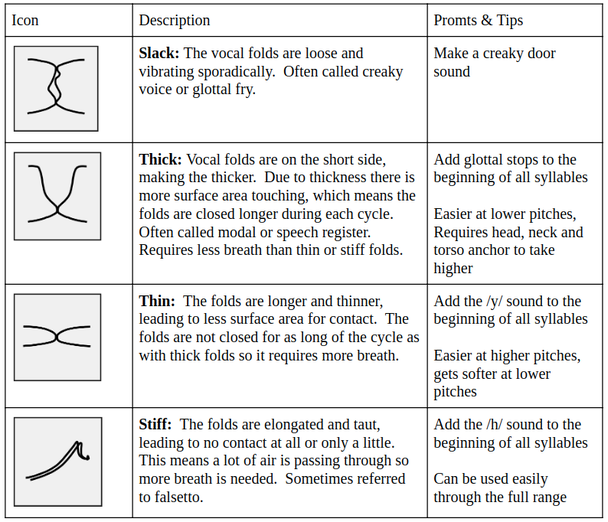TVF Body Cover
True Vocal Fold Body Cover
introduction
 The number of vibrations that the true vocal folds do per second is what determines the pitch. Thus A= 440 Hz means that the vocal folds are closing 440 times per second. The different True vocal Body Cover condition affects the vocal quality and volume of the pitch. When the true vocal folds are thick, they are closed for more of the time for each cycle. When the true vocal folds close the air pressure builds up below them. The longer they are closed, the higher the pressure builds up. When the true vocal folds open, the greater the difference in air pressure below and above the folds, the greater the volume. This is partly why thick folds sound louder than thin folds, and thin folds sound louder than stiff folds.
The number of vibrations that the true vocal folds do per second is what determines the pitch. Thus A= 440 Hz means that the vocal folds are closing 440 times per second. The different True vocal Body Cover condition affects the vocal quality and volume of the pitch. When the true vocal folds are thick, they are closed for more of the time for each cycle. When the true vocal folds close the air pressure builds up below them. The longer they are closed, the higher the pressure builds up. When the true vocal folds open, the greater the difference in air pressure below and above the folds, the greater the volume. This is partly why thick folds sound louder than thin folds, and thin folds sound louder than stiff folds.
These four positions form a spectrum. You can have thicker thin folds and thinner thick folds. Often, when the voice cracks, it is in the middle range where it is easier to do thick, thin, or stiff folds. Because the singer did not tell their folds what to do well enough and the folds vibrate in an uncontrolled manner for a brief time and make the telltale crack sound.
The figure for True Fold Body Cover involves changing from each position to all of the others. So thick to thin, stiff, and slack and thin to thick, stiff and slack etc and doing the tasks on multiple vowel sounds as well as changing between conditions abruptly and gradually. When first practicing the figures, it is helpful to change between the conditions abruptly. You will hear and feel the flip (the little yodel) as you switch from one to another and this is a sign that you have switched conditions. As you learn to control your true vocal folds and the other structures that support moving between the different conditions, then it a good idea to work on switching conditions gradually.
Learning to anchor the head and neck as well as the torso at different effort numbers plays a large role in developing the ability to switch between these conditions.
True Vocal Fold Body Cover Video
In this video, three different singers (two females and one male) have a scope showing what is going on in their larynx as they sing. Each one demonstrates the four conditions for True Vocal Fold Body Cover in the same order—-Slack, Thick, Thin, and Stiff. Notice the length of the True Vocal Folds in each of the four conditions.
TVF Body Cover Audio Lesson
In this audio lesson I explain the different TVF Body Covers conditions and demonstrate how they sound as well as how to use the TVF onset to help induce a particular TVF Body Cover Condition. A glottal onset helps induce thick folds, a smooth onset (like /y/) helps induce thin folds, and the aspirate onset (like /h/) helps induce stiff folds.
Practice
After you have read the explanations, watched the video, and listened to the audio lesson, pick a simple phrase you have memorized and practice chanting it using thick folds, thin folds, and stiff folds. Try it beginning at different pitches and note your effort number. Does it change?
TVF Body Cover Examples
Listen to some of the recordings of Stanitsas chanting the Katavasia of the Publican and Pharisee and the nuns of Ormylia Monastery chanting Blessed is the Man (Psalm 1). Can you tell that they are using Thick Vocal Folds?
